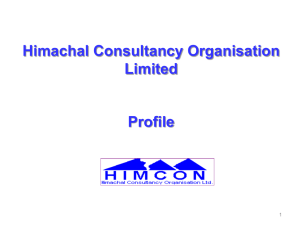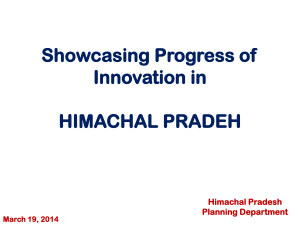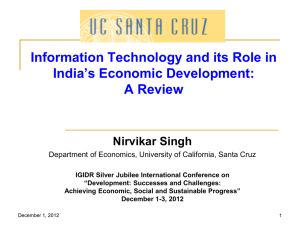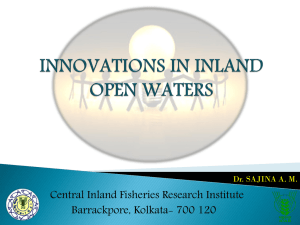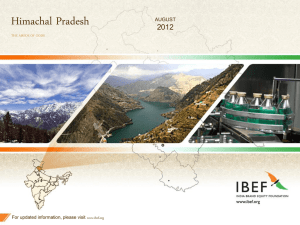INTRODUCTION - INFLIBNET Centre
advertisement
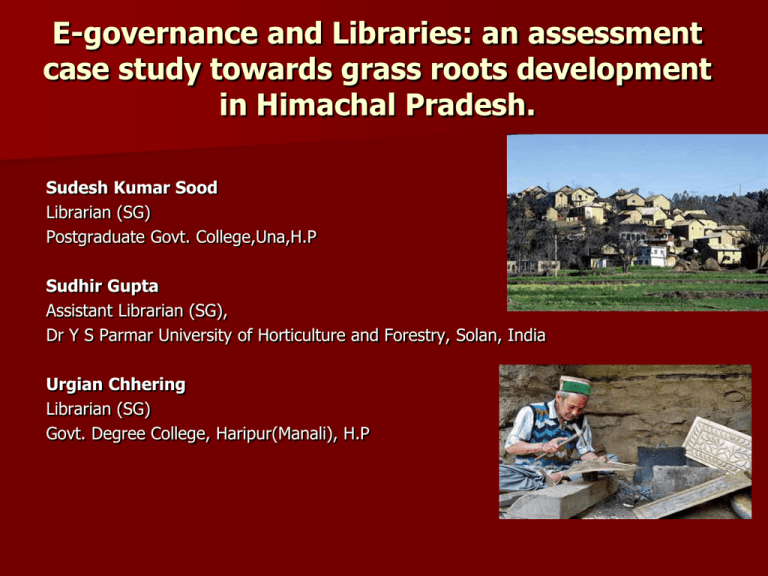
E-governance and Libraries: an assessment case study towards grass roots development in Himachal Pradesh. Sudesh Kumar Sood Librarian (SG) Postgraduate Govt. College,Una,H.P Sudhir Gupta Assistant Librarian (SG), Dr Y S Parmar University of Horticulture and Forestry, Solan, India Urgian Chhering Librarian (SG) Govt. Degree College, Haripur(Manali), H.P Introduction ‘Success is a Journey, Not a Destination’ State of Himachal Pradesh has been blessed with an enormous potential of IT. Every government attempts continuously to bring maximum benefit and happiness to majority of its citizens. If the government takes recourse to electronic means in delivery of public services, then no wonder, it becomes easier and this process of the government is nothing but e-Governance. State has tremendous potential to make it to the top notches in the field of e-Governance. State has received nine National Awards for its consummations in the field of e-Governance Various projects like e-Procurement, e-District, Human Resource Management System (HRMS), Management Information System (HMIS), HIMSWAN, and Grievance Redressal System, various core ICT infrastructure projects like Integrated Community Service Center (i-CoSC) or SUGAM, Himachal Pradesh State Data Center, Secretariat LAN and Hi-Tech City & Software Technology Park are in the process of implementation. Definition of E-Governance E-governance is an emerging trend to re-invest the ways the government work and a new model of governance would be based upon the transactions in virtual space, digital economy and dealing with knowledge oriented societies. In simple words it is the application of ICTs to governmental functioning to accomplish simple, accountable, speedy, responsive and transparent administration in government. E-governance is the public sector’s use of information and communication technologies with the aim of improving service delivery, encouraging citizens in the decision making process and making government accountable, transparent and effective (UNESCO,2010) E-Governance Model The present model of e-governance doesn’t aim to reduce the role of government in the life of citizens but to serve them more timely and efficiently Now it is the government, which tries to adopt itself to the life of a citizen particularly the under privileged as against the traditional model, which is just the opposite of it The emphasis is to make the user in charge of affairs and in command of situation Objectives of E-Governance The objectives of e-governance are to enhance efficiency, provide total transparency, high responsiveness, accountability, convenience and accessibility of services and information from the point of view of citizens From governments perspective it is to abolish corruption, cut in costs, an antidote to ‘Parkinson’s law’ i.e., “works expands to fulfill available” The purpose of this study was to identify the E-Government related information at the library and to identify current library EGovernment practices in Himachal Pradesh in order to provide practical guidance to public libraries to meet the needs of the local community members they serve. Role of E-Governance Increase efficiency by automation, computerization and networking. Supports effective decentralization decision-making by providing an efficient information flow. Increase accountability of public services to agencies to citizens. Improves resource management. Offers the various departments and agencies involved in public service provision, the facility of effective interface with the citizens. Increase the accessibility of individual citizens to information and services and allow them to influence government operations. Provides comprehensive database which helps policy makers to design, formulate and evaluate policies. Facilitates the strategic planning processes which help organization to clearly lay down the objectives, goals, programmers’ and projects. Enables reduction of paperwork with the use of e-mail and electronic data interchange. Enables marketization by supplying information related to the market and enhance public service. E-Governance Infrastructure Projects in Himachal Pradesh HIMSWAN State Data Centre State Portal and SSDG Community Service Centers (CSC) or LokMitra Kendras Integrated Community Service Centers (i-CoSC) or SUGAM Scheme Portal (e-Marg Darshan) E-Samadhan E-Sameeksha E-Kosh HimBhoomi E-Pension (Pension Disbursement System) Digital Gazette (e-Gazette) HIMSWAN Network HIMSWAN Himachal State Wide Area Network or HIMSWAN is the core infrastructure project under NeGP that intends to support various eGovernance initiatives in Himachal Pradesh by providing connectivity to Government Offices and Integrated Community Service Centers at State, District, Sub-Divisional, Tehsil and Block headquarters in the state The HIMSWAN project has been divided into two phases: HIMSWAN I and HIMSWAN II Under the HIMSWAN-I, a Local Area Network with 600 nodes has been established in HP Secretariat The HIMSWAN-II project proposal has been approved by the Ministry of IT, Govt. of India. Various applications which are being run over HIMSWAN include Online HRTC Bus Reservation, SUGAM (Integrated Community Service Centre) bills payment, e-Registration for Electoral rolls, Factory database for Labour and employment, HP Public Service Commission, Online registration for HP Judicial Services Examination, Court Case Monitoring Software for Divisional Commissioner office, Weekly prices of essential commodities and many more. Source: http://hp.gov.in/himswan/ State Data Centre In order to consolidate the G2G, G2B and G2C services, the State Data Centre project has been proposed under NeGP. These services can be rendered by the States through common delivery platform seamlessly supported by core Connectivity Infrastructure such as State Wide Area Network (SWAN) and Common Service Centre (CSC) connectivity extended up to village level. In the case of Himachal Pradesh, the RFP of the project is under review and finalization by DIT/State. Source www. mit.gov.in/ State Portal and SSDG The State Portal of the Himachal Pradesh has been developed by the State NIC unit. Under NeGP, the Government desires to create an integrated information infrastructure that will expand, integrate and enhance the utility and reach of the services provided by the Government by utilizing the network of the Common Service Centres. In order to provide single interface for all the G2C services, the State Portal (SP) along with State Service Delivery Gateway (SSDG) are being developed in the Himachal Pradesh. One can also avail many e-services through the portal that includes RTI Search, Online bill submission, downloadable forms for Birth certificate, Ration Cards, Vehicle registration etc., and links for schemes like Lok Mitra and AGMARKNET etc. Currently, the SP and SSDG project is in its implementation stage Source: www. mit.gov.in/ Community Service Centers (CSC) or LokMitra Kendras An objective to develop a platform enabling Government, private and social sector organizations to align their social and commercial goals, especially for the benefit of the rural population a total of 3366 Common Service Centers have been sanctioned by the Government of India to be setup in Himachal Pradesh Integrated Community Service Centre (i-CoSC) which is an enlarged and improved version of the "LOKMITRA" project (a pilot in Hamirpur District), is being setup in the state providing one-stop shop information resource and service center for the people ensuring greater transparency, effectiveness, neutrality, responsibility and speed. Various services offered by the LokMitra Kendras include Land Records, Employment exchange services (Job Portal), Electoral services, Registration for pension schemes, RTI, Public Grievances (Lokvani / Lokmitra mode), Issuance of Himachali Domicile, Caste and Agriculturist Certificates, HRTC / Railway Booking, all Government forms, AGRISNET Portal services, EKalyan scheme, Examinations results, information related services like Blood donors, Hotel directory, etc., Complaint / FIR registration with Police, REFNIC etc Model of Community Service Centers (CSC) or LokMitra Kendras Structure ofCommunity Service Centers (CSC) or LokMitra Kendra NIC Himachal Pradesh State Unit is in the process of establishing Statewide Government INTRANET, connecting the State Secretariat, all the Directorates & State level Offices, all the District Collectorates & District level Offices of all the Departments/ Blocks & Tehsils with each other. This project is being executed as a joint project between NIC and the State Govt. District level Web Servers will be installed at the District Collectorates accessed by the respective District level Offices/ Blocks & Tehsils also. State level Web Servers will be installed at the Secretariat accessed by the Directorates and other State level Offices. The State-wide INTRANET will facilitate information flow from District level offices to the District Web Servers at the Collectorates, and then to the LokMitra Web Server. Similarly, from Directorates to the State Web Server at the Secretariat, and then to the LokMitra Web Server. The LOKMITRA Web Server will be installed at the NIC Headquarters accessed by the Citizen Information Centres through Internet. IT enabled Citizen Services With the maturing of IT in India, there has been a shift in focus with emphasis being on providing more citizen services. The NIC HP has implemented the following citizen centric projects: Electoral Rolls: The Electoral Rolls of HP, in Hindi, covering 42 Lakh electors have been published on the HP Government website and can be searched on name, polling station and serial number wise. Web enabled Hotels Reservation System software: The Web Enabled Hotels Reservation System software developed and implemented for the HP Tourism Development Corporation, with hotels CITIZEN CENTRIC ADMINISTRATION Integrated Community Service Centers (i-CoSC) or SUGAM i-CoSC (Sugam) brings all citizen related services and information under a single roof, cutting across different tiers of administration, providing services at the doorstep of rural community A number of SUGAM Centers have been setup at all Tehsils/ Sub-Tehsils, SubDivisions and District Headquarter of Shimla District and now are being rolled out in other districts as well. The project enables document submission and collection of licenses or certificates at a place other than the place of sanction (except where physical presence is necessary as per law). Various services like Voter Registration and Issuance of Voter Id, Land record (Nakal/ Jamabandi), Revenue (HimBhoomi-Land records forms), Transport(Vahan – Vehicle registration and Saarthi – Driving license), Bus booking & Time table; Caste certificates, Vacancy listings, Electricity and telephone bills, REFNIC -Reference Monitoring of Files, Tourist Information etc. can be availed through the SUGAM centers. Source: http://hp.gov.in/sugam/ Scheme Portal (e-Marg Darshan) In order to provide opportunities to the citizen for their economic and social development, the State Government has launched e-Marg Darshan project The portal attempts to provide easy and single point access to information about the various Welfare Schemes being provided by the State Government for the citizens and other stakeholders. Through this portal a citizen can identify schemes for which he is eligible, simply by providing information pertaining to his Gender or Age or Caste or APL/BPL status or Occupation or Annual Income Source: http://hp.gov.in/scheme/home/home.aspx E-Samadhan E-Samadhan is the Grievance Redressal System portal of the Government of Himachal Pradesh. It is web-based software for speedy redressal of grievances that has been developed by NIC, Himachal Pradesh using ASP.NET. The software gives an instant view of the grievance to both, the concerned office and the public. It also shows the department-wise pendency summary of the grievance. Implementation of this project has resulted in enhanced transparency and accountability along with reduction in paper work and corruption. Source: http://admis.hp.nic.in/eSamadhan E-Sameeksha E-Sameeksha is an e-Governance initiative of Government of Himachal Pradesh for effective monitoring of various schemes rolled out by the Government. Source: http://admis.hp.nic.in/esameeksha/Default.aspx E-Kosh E-Kosh is a web portal developed by the Department of Finance to provide State financial reports online. It provides the reports of the Finance Department as well as other Departments of the state. Source: http://himachal.nic.in/treasury/eKosh.htm HimBhoomi Developed by NIC state Unit, the HimBhoomi software is a futuristic Land Record System that is helping out in resolving the Land Record related issues in the state. The software is an exact replica of existing manual system with improvements & compatible to requirements thereby enabling its replication without any resistance from the revenue staff. The software comes with built-in user manuals and can be used easily by village patwari. The software has following five modules: Gram Nideshika Master Entry Module HimBhoomi-LaPort Module HimBhoomi-Mutation Module HimBhoomi-ROR (Nakal) Distribution Module Efforts are on to enable encryption/decryption of data in the system. Also, the system will be linked with GIS system and integrated with HIMRIS (Himachal Registration Information System). Source: http://himachal.gov.in/himbhoomi/AboutHimbhoomi.htm E-Pension (Pension Disbursement System) The e-Pension software is the result of complete reversal of the manual system of pension disbursal and has resulted in direct benefits to both the State Government and to the pensioners during pilot implementation of the project in the Districts of Solan and Una since June 2001. The main objectives of the project include: Improvise accounting system for recovery of pre-1966 pension amounts from other states Providing a 24x7 interface for information and grievance redressal Ensuring compliance with Pension Rules A number of process and procedural changes have been made as part of the implementation. These include: Pension Processing at District Treasury only instead of the sub-treasuries/ bank branches Pension disbursal through bank accounts only The web-interface of the software is available http://himachal.nic.in/epension where the details of individual’s pension are displayed for the last 12 months. The project won the Golden Icon Award for Innovative Operations & Best PracticesProfessional category in the 9th National e-Governance Conference held at Kochi, Kerala in the year 2006. Source: http://admis.hp.nic.in/epension/epensionkhoj.asp Digital Gazette (e-Gazette) Being one of its own kinds, Digital Gazette is the first paperless, completely digitized official Gazette in India, which was first published in Himachal Pradesh. The whole process has been decentralized as all departments send their notifications for publication now only through the S/W interface. This has resulted in huge cost savings to the State Government besides benefiting the citizens, lawyers, bankers, departments, employees, as any Gazette notification issued after the cut-off date is available on the Internet in searchable format. This exemplary initiative has won the Bronze Icon Award under Category I-Excellence in Government Process Reengineering in the National e-Governance Conference held in Goa on 12th and 13th of February 2008. Source: http://himachal.nic.in/egazette Role of Libraries in promotion of EGovernance Already established libraries especially public libraries can be used as information centers or public kiosks in the absence of basic infrastructure These libraries can work as depository libraries for all types of government information from where the public can access and monitor the work of its elected officials and policy makers. Libraries can also help to bridge divide in the digital contents by providing special services to the general public. Libraries ensure to freedom to speech, the freedom to read and freedom to view. When the people are better informed, they are more likely to participate in the political process, thus keeping an eye on their elected representatives and making them more accountable. Local and state government needs access to information from comparable jurisdiction in order to do their work effectively and efficiently In the field of information literacy, library professionals can play a pivotal role. Besides acting as facilitators and tutors, they can also act as aspirators’ and help along with teaching community to spread the culture of information literacy. Role of Libraries in promotion of E-Governance In the words of James Madison “Knowledge will forever govern ignorance and that people who mean to be their own governors must arm themselves with the power that knowledge gives. A popular government without popular information or means of accruing is it but a prologue to a force or tragedy perhaps both”. The main trust in this area should go to the rural public library. A village or a village cluster with an adequate population should have a community library which will also serve as an information centre. The Seventh plan Working Report of the Planning Commission states that “No community, institution or organization is considered complete without a good library service. According to the Library Association, Britain, “Community Information Services assist individuals and groups with daily problem solving and with participation in the democratic process. There are two major roles that public libraries play in the delivery of e-governance. The first, information access, involves working in partnership with other areas of the organization or other tiers of government to deliver and distribute information personally, seamlessly, wherever and whenever it is desired. The second bridging the digital divide, is achieved by providing access to information, developing training programmes in the community, ensuring that all people have to access to information, and by understanding the impact of new technologies in the life of people. Community information services via the EGovernance Services provided at the villager’s door steps via the e-governance route can presumably cut out the inherent social biases. The important task of e-governance is to remain in touch with the concerned authorities in villages, blocks, tehsil and districts and even in the Metropolis. Richard Heeks points out that governance is both, the present and the future of developing countries like India, which still have a long way to go. Currently, more than half of India’s villages lack telephone connectivity, let alone internet access. The 26 million phone lines (mostly business-owned) and 2 million internet subscribers that do exist nationwide are concentrated in urban areas, while rural community are left out of the loop. ICT has made services amenable to people living in cities and villages. The GYANDOOT programme in Madhya Pradesh, the e-Seva network in Andhra Pradesh, FRIENDS (Fast, Reliable, Instant, Efficient, Network for Disbursement of Services) in Kerala, the Saukaryam project in Vishakapatnam, the GRAMSAT project in Orissa, eGram Suvidha in 5 districts i.e. Chhattarpur, Bhopal, Dhar, Madla and Damoh of Madhya Pradesh, Lokvani Sitapur, Uttar Pradesh and Lok Mitra in Himachal Pradesh are efforts to foster connectivity, accessibility to services and information to the people. Conclusion E-governance is step towards reform in government and administration. These reforms focus on bringing improvements in the service delivery, dissemination of information, transparency, public and private partnership, efficiency and accountability. There is an urgent need for sustainable development, In developing countries like India, it is not easy to fulfill all the pre-conditions. E-Governance is also seen as a multi- dimensional concept an IT driven methodology that improves efficiency in administration, brings about transparency and leads to reduction of costs in running the government. There are three main domains of egovernance: improving governmental processes (e-administration); connecting citizens (e-citizens and e-services); and building external interaction (e-society). Himachal Pradesh Government, have taken several initiatives for rural development through community information centers. These may be considered as rural electronic libraries. The project has been started in Himachal Pradesh to provide IT facility in each and every block. Each CIC will have one server computer system and five client configuration computer systems linked in a local area network and connected to a V– SAT for Internet access From the above assessment it can be concluded that Himachal Pradesh has made encouraging efforts to bridge the gap by initiating a number of projects and programmes for rural and remote locations, a lot more needs to be done to bring the people into the information society.
